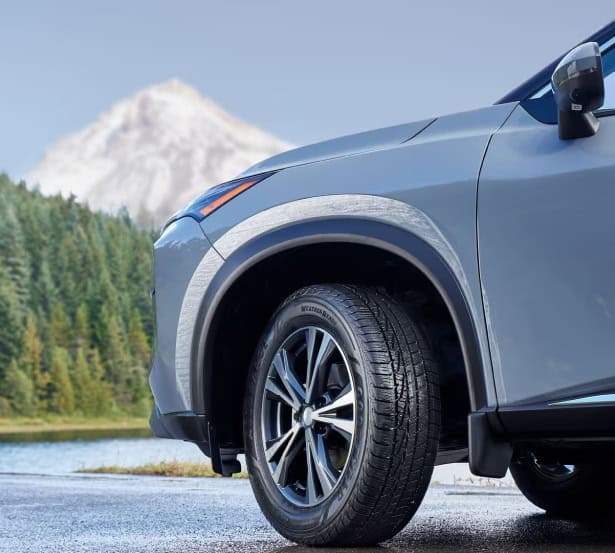As winter approaches, Ford truck owners across Canada and other snowy regions face the annual challenge of preparing their vehicles for harsh weather conditions. Selecting the right winter tires and navigating treacherous roads are crucial for safety and performance.

The Importance of Winter Tires for Ford Trucks
Ford trucks, known for their ruggedness and capability, still benefit significantly from winter tires. Even with features like four-wheel drive or all-wheel drive, the right tires can significantly improve traction, handling, and braking on snow and ice.
Why All-Season Tires Aren’t Enough
While all-season options are versatile, they’re a compromise that doesn’t excel in extreme conditions. Winter options are designed with specific features that make them superior in cold weather:
- Softer rubber compounds that remain flexible in freezing temperatures
- Deeper tread patterns to channel snow and slush
- Numerous sipes (small slits) that create biting edges for ice traction
Top Winter Tire Options for Ford Trucks
Here are some of the best winter tire brands for Ford trucks based on performance, durability, and value:
Bridgestone Blizzak DM-V2
The Blizzak DM-V2 is a standout choice for Ford truck owners. It offers exceptional performance on ice and snow, and its unique multi-cell compound disperses water from the tire surface for improved traction.
- Pros: Excellent ice performance, good snow traction, quiet ride
- Cons: Relatively expensive, may wear faster on dry roads
Michelin X-Ice Snow SUV
Michelin’s X-Ice Snow SUV is a newer model that provides excellent all-around winter performance for trucks and SUVs.
- Pros: Long tread life, good dry road handling, excellent ice traction
- Cons: Premium pricing, slightly less aggressive in deep snow compared to some
Goodyear Ultra Grip Ice WRT
This option is for light trucks and SUVs. It offers a good balance of on-road comfort and off-road capability in winter.
- Pros: Good snow and ice traction, comfortable ride, decent tread life
- Cons: Not as strong on ice as some premium competitors
Nokian Hakkapeliitta LT3
Nokian, a Finnish company, knows something about winter driving. The Hakkapeliitta LT3 is a studded option providing unparalleled ice traction.
- Pros: Best-in-class ice traction, excellent snow performance, good for off-road winter use
- Cons: Expensive, noisy on dry roads, not legal in all provinces
Continental VikingContact 7
A newer entry in the winter tire market, the VikingContact 7 has impressed with its overall winter performance.
- Pros: Excellent snow traction, good ice performance, comfortable ride
- Cons: Limited sizes available, less well-known than some competitors
Choose the Right Winter Tires for Your Ford Truck
When selecting winter tires for your Ford truck, consider the following factors:
- Size: Ensure you choose the correct size for your specific Ford model. You can find this information in your owner’s manual or on the driver’s side door jamb.
- Driving Conditions: Consider the typical winter conditions in your area. If you frequently encounter deep snow or ice, a more aggressive tire might be necessary.
- Budget: While saving money is tempting, remember that they are your only point of contact with the road. Investing in quality winter tires can significantly improve safety.
- Load Rating: Ensure the tires you choose can handle the weight of your truck, especially if you use it for towing or hauling.
- Studs or No Studs: Studded tires provide the best traction on ice but are not legal in all areas and can be noisy on dry roads.
Installation and Maintenance
You should install winter tires when temperatures consistently fall below 7°C (45°F). Here are some tips for installation and maintenance:
- Install a full set of four winter tires for balanced handling and traction.
- Consider purchasing a separate set of wheels for your winter tires to make seasonal changes easier.
- Maintain proper pressure, which can fluctuate with temperature changes.
- Rotate your winter tires regularly to ensure even wear.
- Store winter tires properly during the off-season in a cool, dry place.
Tips for Ford Trucks in Snowy and Icy Conditions
Even with the best winter tires, driving in snow and ice requires skill and caution. Here are some essential tips for Ford truck owners:
Understand Your Truck Features
Modern Ford trucks come with various traction and stability control systems. Familiarize yourself with features like:
- AdvanceTrac with Roll Stability Control
- Hill Descent Control
- Selectable Drive Modes (if equipped)
Know how to engage 4WD or AWD properly and when to use low-range gearing if available.
Prepare Your Truck
Before winter hits:
- Check and replace wiper blades if necessary
- Top up washer fluid with a winter-grade solution
- Test your battery, as cold weather reduces battery performance
- Ensure your engine coolant is rated for winter temperatures
Adjust Your Driving Technique
- Accelerate and Decelerate Slowly: Applying the gas slowly helps maintain traction. When slowing down, plan well in advance and brake gently.
- Increase Following Distance: Leave more space between you and the vehicle in front. A good rule of thumb is to maintain at least 8-10 seconds of following distance in snowy conditions.
- Don’t Stop If You Can Avoid It: It takes more effort to start moving from a full stop on snow. If you can slow down enough to keep rolling until a traffic light changes, do it.
- Don’t Power Up Hills: Applying extra gas on snow-covered roads will just make your wheels spin. Try to get a little inertia going before you reach the hill, and let that carry you to the top. As you reach the crest, reduce speed and proceed downhill slowly.
Know How to Handle Skids
If your truck starts to skid:
- For Rear-Wheel Skids: Steer in the direction you want the front of the truck to go, which may feel counterintuitive, but it helps straighten out the vehicle.
- For Front-Wheel Skids: Shift to neutral and point the wheels where you want to go. When you feel traction returning, gently accelerate.
Use Your Truck’s Weight Advantageously
Ford trucks, especially when properly loaded, have a weight advantage that can improve traction. However, be cautious as the extra weight also increases stopping distance.
Be Prepared for Emergencies
Always carry an emergency kit in your truck during winter, including:
- Blankets
- Extra warm clothing
- A shovel
- Sand or kitty litter for traction
- Snacks and water
- A first-aid kit
- A flashlight with extra batteries
- A phone charger
Practice in Safe Conditions
If possible, practice winter driving techniques in a safe, open area like an empty parking lot. This can help you understand how your Ford truck handles in slippery conditions.
Stay Safe with Winter Tires on Ford Trucks
Equipping your Ford truck with quality winter tires is crucial in preparing for winter driving. Brands like Bridgestone, Michelin, Goodyear, Nokian, and Continental offer excellent options tailored for trucks. Remember, the best option for you depends on your specific needs, driving conditions, and budget.
However, even the best tires can’t replace cautious driving and proper preparation. You can navigate winter roads safely and confidently by understanding your truck’s features, adjusting your driving technique, and staying prepared for emergencies.
Winter driving presents unique challenges, but with the right tires and knowledge, your Ford truck can be a reliable and safe vehicle for all your winter adventures. Stay safe, drive carefully, and enjoy the capabilities of your Ford truck this winter season.






